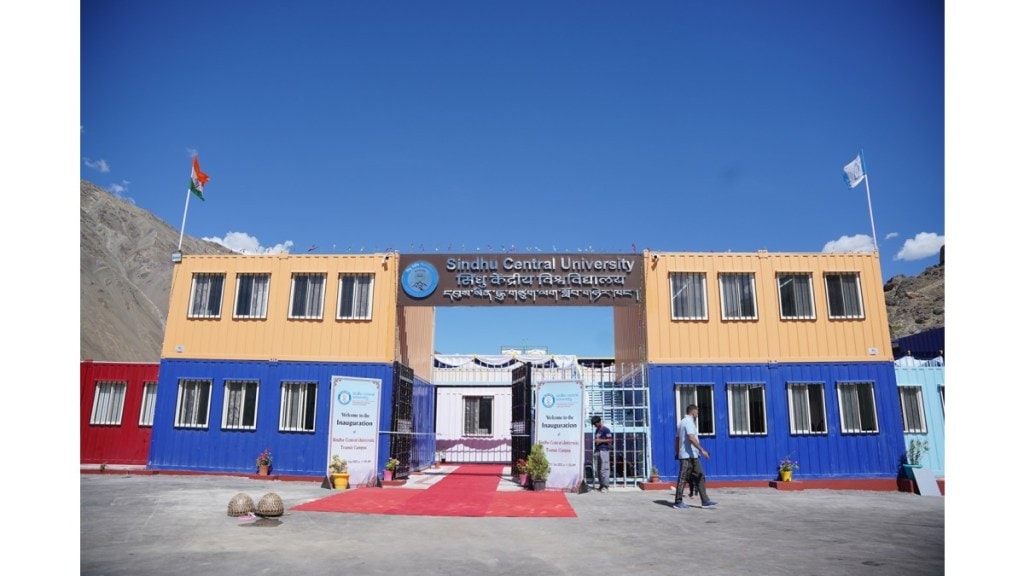Last week, the Sindhu Central University (SCU) held its first convocation in Leh, Ladakh, where 14 students were conferred with degrees. It was held at the Central Institute of Buddhist Studies (CIBS), Choglamsar, Leh, and was attended by the chief secretary of Ladakh, Pawan Kotwal, and the chair of the SCU’s Executive Council, Prof V Kamakoti (director of IIT Madras – the mentor institute of the SCU).
What is the SCU?
Claimed to be the world’s highest university – at about 3,500 metres above sea level – the SCU is coming up at Khaltse, 100 km west of Leh, towards Kargil. It’s named after the river Sindhu (Indus), and is India’s first trans-Himalayan Central University. It was created to fill the higher education gap in Ladakh, after the region became a Union Territory in 2019, and PM Narendra Modi laid the foundation stone virtually in February 2024.
What’s the current status?
The first 14 students studied at IIT Madras and IIT Kanpur (mentoring institutes), but last week a transit campus opened at Khaltse, near the location of the main campus, which will come up in 110 acres and is expected to be ready by 2028. The chancellor is the Lieutenant Governor of Ladakh, the vice-chancellor’s post is vacant, and Prof Kamakoti chairs the Executive Council.
What will be the courses?
Prof Kamakoti told FE that the focus will be on climate sciences, Buddhist studies, sustainability, atmospheric sciences, and subjects related to Ladakh’s unique environment and policy needs. Currently, the SCU offers three postgraduate degree programmes: MTech in Atmospheric & Climate Sciences (2 years, 20 students, being held at IIT Madras); MTech in Energy Technology & Policy (2 years, 20 students, being held at IIT Kanpur); MA in Public Policy (2 years, 20 students, being held at IIT Madras); and MA in Buddhist Studies (just launched, and will be held at the transit campus). Admissions will be merit-based, through GATE scores and interviews. The faculty will be drawn from top institutions, and recruitment is going on.
What does it aim to achieve?
Prof Kamakoti said that the short-term goal is to operate successfully from the transit campus, as the permanent campus is being constructed. The long-term goal is to have at least 1,000 students on the campus (of which 50 will be from foreign countries), and become an international centre for high-altitude, climate, and energy research.
What challenges can it face?
– The biggest is geographic and environmental challenges. In Ladakh, the construction work stops for 3-4 months due to extreme cold, and this means the timeline for the main campus might face delays.
– Once operational, there might be limited access to resources, and to convince top faculty, administrative personnel, and researchers to relocate to Ladakh. Non-Ladakhi students/faculty might face high altitude sickness during the first few days on the campus.
– Although it has received substantial funding (by the government of India through the Ministry of Education) and the initial approval was for Rs 750 crore, in the long-term the SCU will have to build its own funding streams through collaborations, research grants, and industry partnerships – and for a university as unique as this, there are no prior case studies or examples.
– It will have to make sure that its programmes and courses align with local needs even in the long term. It will also need to ensure that it preserves local identity even if it becomes a global university.
– The SCU might have to face the effects of accelerated climate change, as research as shown that high-altitude regions are warming much faster than the global average, and shrinking glaciers and reduced snowfall may lead to water scarcity.
– Lastly, the SCU may have to take steps to reduce its carbon footprint, which could be exacerbated by academic air and road travel, heating needs, deforestation, etc.
Is it really the world’s highest university?
Although university executives claimed thus, the Tibet University in Lhasa is located at an altitude of 3,650 metres above sea level – and has long been recognised as the world’s highest university by altitude (established in 1985). Therefore, the SCU is one of the highest universities with a centralised campus, government recognition, and a broad academic mandate.


